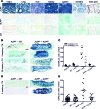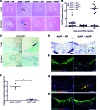Tracking mesenchymal stem cell contributions to regeneration in an immunocompetent cartilage regeneration model
- PMID: 29046476
- PMCID: PMC5846895
- DOI: 10.1172/jci.insight.87322
Tracking mesenchymal stem cell contributions to regeneration in an immunocompetent cartilage regeneration model
Abstract
It is currently controversially discussed whether mesenchymal stem cells (MSC) facilitate cartilage regeneration in vivo by a progenitor- or a nonprogenitor-mediated mechanism. Here, we describe a potentially novel unbiased in vivo cell tracking system based on transgenic donor and corresponding immunocompetent marker-tolerant recipient mouse and rat lines in inbred genetic backgrounds. Tolerance of recipients was achieved by transgenic expression of an immunologically neutral but physicochemically distinguishable variant of the marker human placental alkaline phosphatase (ALPP). In this dual transgenic system, donor lines ubiquitously express WT, heat-resistant ALPP protein, whereas recipient lines express a heat-labile ALPP mutant (ALPPE451G) resulting from a single amino acid substitution. Tolerance of recipient lines to ALPP-expressing cells and tissues was verified by skin transplantation. Using this model, we show that intraarticularly injected MSC contribute to regeneration of articular cartilage in full-thickness cartilage defects mainly via a nonprogenitor-mediated mechanism.
Conflict of interest statement
Figures




Similar articles
-
Intra-articularly injected mesenchymal stem cells promote cartilage regeneration, but do not permanently engraft in distant organs.Sci Rep. 2019 Jul 12;9(1):10153. doi: 10.1038/s41598-019-46554-5. Sci Rep. 2019. PMID: 31300685 Free PMC article.
-
Hematopoietic bone marrow cells participate in endothelial, but not epithelial or mesenchymal cell renewal in adult rats.J Cell Mol Med. 2011 Oct;15(10):2232-44. doi: 10.1111/j.1582-4934.2010.01216.x. Epub 2011 Aug 4. J Cell Mol Med. 2011. PMID: 21091631 Free PMC article.
-
Neonatal desensitization supports long-term survival and functional integration of human embryonic stem cell-derived mesenchymal stem cells in rat joint cartilage without immunosuppression.Stem Cells Dev. 2013 Jan 1;22(1):90-101. doi: 10.1089/scd.2012.0116. Epub 2012 Aug 14. Stem Cells Dev. 2013. PMID: 22788986 Free PMC article.
-
Mesenchymal Stem/Progenitor Cells Derived from Articular Cartilage, Synovial Membrane and Synovial Fluid for Cartilage Regeneration: Current Status and Future Perspectives.Stem Cell Rev Rep. 2017 Oct;13(5):575-586. doi: 10.1007/s12015-017-9753-1. Stem Cell Rev Rep. 2017. PMID: 28721683 Review.
-
Advances in mesenchymal stem cell-based strategies for cartilage repair and regeneration.Stem Cell Rev Rep. 2014 Oct;10(5):686-96. doi: 10.1007/s12015-014-9526-z. Stem Cell Rev Rep. 2014. PMID: 24869958 Review.
Cited by
-
Mesenchymal or Maintenance Stem Cell & Understanding Their Role in Osteoarthritis of the Knee Joint: A Review Article.Arch Bone Jt Surg. 2020 Sep;8(5):560-569. doi: 10.22038/abjs.2020.42536.2155. Arch Bone Jt Surg. 2020. PMID: 33088856 Free PMC article. Review.
-
Specificities of Scanning Electron Microscopy and Histological Methods in Assessing Cell-Engineered Construct Effectiveness for the Recovery of Hyaline Cartilage.Methods Protoc. 2021 Oct 27;4(4):77. doi: 10.3390/mps4040077. Methods Protoc. 2021. PMID: 34842796 Free PMC article.
-
ADSC-Based Cell Therapies for Musculoskeletal Disorders: A Review of Recent Clinical Trials.Int J Mol Sci. 2021 Sep 30;22(19):10586. doi: 10.3390/ijms221910586. Int J Mol Sci. 2021. PMID: 34638927 Free PMC article. Review.
-
The Effect of Blood-Derived Products on the Chondrogenic and Osteogenic Differentiation Potential of Adipose-Derived Mesenchymal Stem Cells Originated from Three Different Locations.Stem Cells Int. 2019 Dec 31;2019:1358267. doi: 10.1155/2019/1358267. eCollection 2019. Stem Cells Int. 2019. PMID: 32082382 Free PMC article.
-
Uniaxial Cyclic Stretching Promotes Chromatin Accessibility of Gene Loci Associated With Mesenchymal Stem Cells Morphogenesis and Osteogenesis.Front Cell Dev Biol. 2021 Jul 7;9:664545. doi: 10.3389/fcell.2021.664545. eCollection 2021. Front Cell Dev Biol. 2021. PMID: 34307349 Free PMC article.
References
Publication types
MeSH terms
Substances
Grants and funding
LinkOut - more resources
Full Text Sources
Other Literature Sources
Medical
Molecular Biology Databases
Research Materials

